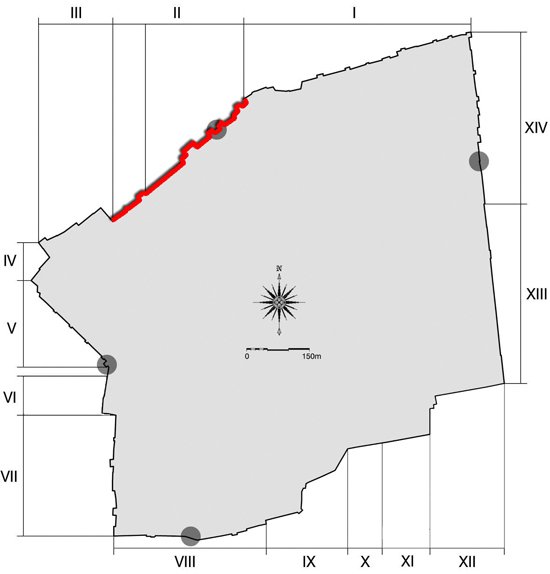|
|
| The Damascus Gate Section |

|
Historic Overview:
The Damascus Gate section is located in the middle of the city's northern wall and the gate structure is situated in its center. Damascus Gate is the most monumental of the city gates.
In the Second Temple period, before the time of Herod, the region where Damascus Gate is situated lay outside the city limits. During Herod's reign the city was expanded to the north and the Second and Third Walls, which encircled residential areas, were built.
Some researchers believe the gate was first erected at the time of Agrippa I, in the mid first century CE. If so, then the ancient gate structure was incorporated in course of the Third Wall.
Roman Period.
The course of the northern wall known to us today was first delineated in the Roman period, at the time Aelia Capitolina was constructed on the ruins of Jerusalem. The Roman gate is generally dated to the early second century CE, to the reign of Emperor Hadrian. It was erected as part of the city's construction projects, as a triumphal arch and gateway to the city.
In the late third or early fourth century the city wall was built and connected to the gate structure. A square was located near the gate, in the middle of which a statue of Emperor Hadrian presumably stood on a high decorated column. The gateway's square was connected to the city's network of main streets, the main cardo and secondary cardo.
The Roman gate continued to be used in the Byzantine period and Early Islamic period.
In the Crusader period the walls were breached and were re-built following the conquest of the city. Of the three gates in the northern wall, Damascus Gate continued to serve as the main entrance to that side of the city.
In the Crusader period a complex of rooms was built next to the gate's outer fa?ade which closed off the entrances thereby necessitating the use of inside openings. The rooms were used as storerooms and the gate was access through them.
Ottoman Period. In the Early Ottoman period the city was neglected and its walls were in ruins. Around 1535 the Ottoman sultan Suleiman ordered his military architects to fortify Jerusalem. This large and imposing gate was designed by Sinan, Sultan Suleiman's the court architect. In the inscription affixed above the gate it states the portal was built in the year 1538. The architect Sinan based the planning of Damascus Gate on the ancient Roman remains, and removed the later medieval additions. Instead of a gate with three openings a single gateway was built that was raised above the previous level. From the time it was constructed until the present no significant changes have been made to the gate's structure.
Nineteenth Century. The northern fa?ade of the gate has been photographed from the second half of the nineteenth century. These pictures document the change the gate has undergone and its environmental-urban context. In the mid-nineteenth century the area around the gate was exposed. Mounds of soil covered the remains of the ancient gate. As the city developed buildings were constructed close to the outside of the gate. These structures formed a kind of outer gate plaza that connects the New City with the Old City.
During the British Mandate fundamental changes relating to the walls in general and the gate in particular were implemented. The city walls were now considered a historic monument. The buildings from the nineteenth century were removed and a gateway plaza was created that distinguishes the Old City from the New City. Along with the spatial changes, the intervention in the gate structure included the stabilization and completion of the crenellations and their decorations.
In 1937-1938 R.W. Hamilton excavated the area of Damascus Gate and remains dating to the Roman period were uncovered for the first time.
State of Israel. In the 1980s archaeological excavations were conducted close to the gate in which the Roman gate structure was exposed on a level that is lower than the Ottoman gate. In the wake of the discoveries the gateway square was re-designed. Now it incorporates a descent to the level of the ancient square where the East Jerusalem Development Corporation has prepared a museum that presents the period in maps, illustrations and photographs.
Damascus Gate Excavations. In 1964-1966 J.B. Hennessy and C.M. Bennett of the British School of Archaeology conducted an archaeological excavation next to Damascus Gate at which time they exposed the fa?ade of the gate's eastern opening, remains from the Middle Ages, the front gate and adjacent buildings.
In 1979-1984, in the wake of a decision by the Jerusalem municipality to renovate the gate area, excavations were carried out under the direction of Menachem Magen. During these years the eastern gate was revealed in its entirety, as well as the gate towers. Parts of the Roman gate were exposed, among them the eastern arch of the three arches of the gate structure, remains of the eastern and western towers and the pavement of the Roman gateway plaza.
The remains that were exposed of the gate structure and tower were built of stones that were originally part of the Herodian construction, from the destruction of the Second Temple.
|
|

|
| Orientation map |
|
 |
 |
|
|
| Websites, text and photos © Israel Antiquities Authority |
Powered by teti-tu |
|
|















